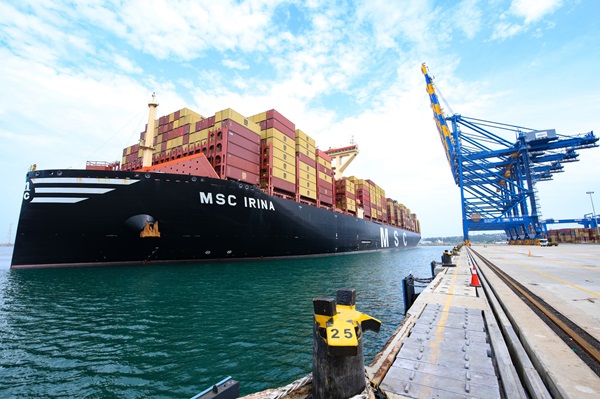.png)

Michael Patra is an economist, a career central banker, and a former RBI Deputy Governor who led monetary policy and helped shape India’s inflation targeting framework.
July 1, 2025 at 3:58 AM IST
On June 9, the world’s largest container ship, the Mediterranean Shipping Company (MSC) Irina, docked at Vizhinjam international seaport in Thiruvananthapuram, Kerala. The Irina has a capacity of 24,346 twenty-foot equivalent units (TEUs), with a length of 399.9 metres and a width of 61.3 metres — more than four times bigger than a standard FIFA-designated football field.
This tale is not about Irina, though; it is about India quietly punching much above her weight in a determination to take a pole position in the world as a maritime hub. With a coastline of over 11,000 km washed by a bay, a sea, and an ocean, and a proud seafaring history stretching back to the fifth millennium BCE, this would appear to be a natural comparative advantage. Yet, it is one of the most fiercely contested domains globally. Seven of the top ten container traffic ports are in China, a hegemony interrupted only by Singapore (third), Busan in South Korea (fifth) and Jebel Ali in the UAE (tenth).
Nevertheless, we are getting there, softly but surely. Nine Indian ports currently rank among the top 100 in the World Bank's Container Port Performance Index, with the country’s largest and busiest port, the Jawaharlal Nehru Port Trust, at the 26th position. It is likely to be eclipsed by the Vadhavan port, being built off the coast of Dahanu in Maharashtra. The goal is to expand national port capacity from the current 1,600 million metric tonnes (MMT) to over 10,000 MMT by 2047, emerging as a global shipping hub. At today’s pace, an Indian port is likely to burst into the top ten in the world by 2034.
Alongside, India is ambitiously engaging in shipbuilding, which includes the construction, repair, and maintenance of vessels used for transportation, defence, and trade. Currently, India ranks in the 20s globally, with a share of less than 1% in global shipbuilding and just 2% in global tonnage. However, these modest shares are a reflection of the enormous strides that can be made.
The aim, according to the Ministry of Ports, Shipping and Waterways, is to reach the top 10 by 2030, and the top five by 2047. Besides building larger and more modern ships to increase gross tonnage and market share, India will need approximately 700 commercial vessels by 2047 to replace its ageing fleet.
Scenting this potential surge in demand, several shipyards are looking ahead with exuberant optimism. Currently, most of our shipyards are capable of building vessels with a deadweight tonnage (DWT) of up to 10,000 tonnes. Bigger ships of the Panamax class (50,000-80,000 DWT), the Aframax class (80,000-120,000 DWT) and the Suezmax class (120,000-200,000 DWT) will call for a significant upgrade of existing infrastructure, sizable long-term capital investment and large land parcels for dry docks.
As a late entrant in a fiercely competitive arena, Indian shipyards will also have to be cost-competitive relative to China. Supply chain management will hold the key, as engines, propulsion systems, ancillaries, and even high-tensile steel plates must be imported and assembled. Repair and maintenance will also consume resources over the average lifespan of a ship, which is approximately 25 years. In turn, this will spur the development of downstream activity as connectivity with the hinterland is upgraded, with imported inputs increasingly made in India.
The time has come. Plans are afoot to set up maritime clusters along the coastline.
Several shipyards are acquiring land. Tie-ups with foreign shipbuilders are on the anvil. India must pack dreams with ambition and realise them.
The aspiration to become a manufacturing powerhouse — a shop floor of the world — must also find expression beyond our borders in market places overseas. Our share in world exports of merchandise has to rise from below 2% to 5% for India to become an export hub.
The openness of the economy, measured by the share of exports and imports in GDP, can rise from the current 44% to as close to 100% as possible — a tradable GDP! For this to happen, we need world-class ships and world-class ports, as 95% of India’s trade by volume is accounted for by the maritime sector even now.
If the various ratios that currently describe India’s maritime sector look miniscule today by global standards, it is worthwhile to remember that India is number three in the world in ship recycling by tonnage. India is also the third largest supplier of seafarers globally.
Near my home, the mighty Mahanadi meanders on its way to meet the Bay of Bengal. Today, it is heavily silted, but eons ago, the river flowed freely into the Bay and was navigable. Every year on the day of Kartika Purnima, just when autumn is releasing, twig by twig, the trees along its banks to winter, women gather in bright colourful attire, decked with flowers, their foreheads crimson with the obeisance performed at the temple on the river’s side.
They place little boats on the rippling swell of the Mahanadi to remember an ancient maritime tradition when their loved men — sadhabas — would set sail in their huge boats — boitas — to trade and spread their culture in Bali, Java, Sumatra, Borneo, Sri Lanka and various parts of Southeast Asia. Historians record that these voyages occurred as far back as the 5th century BC. In those days, Odisha or Kalinga boasted of famous ports such as Tamralipti, Palur, Pithunda, Chelitalo, Manikpatna, among others, that were known widely in the context of sea passages from India to other parts of Asia. Similar festivals celebrated at around the same time as Bali Jatra in Cuttack, Odisha, featuring sailing of toy boats are still found in Bali, Thailand.
This is an ode to those ancient mariners, and to those that dream of India as the maritime power of tomorrow.
It is said that history does not repeat itself, but it often rhymes.
*“I must go down to the seas again” is from the poem Sea-Fever written by John Masefield.




